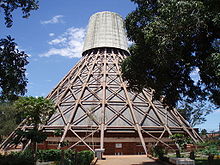Roman Catholic Church in Uganda
The Roman Catholic Church in Uganda is part of the worldwide Roman Catholic Church , under the spiritual guidance of the Pope and the Curia in Rome. It includes the Roman Catholic dioceses in the East African state of Uganda.
history
The people of Uganda had their first contact with the Catholic Church through the religious of the Society of Missionaries of Africa ( Fathers Albi ), Father Siméon Lourdel and Brother Amans, who settled in Buganda in 1879 . In the following years there were repeated violent clashes among the various religious groups and between the state and Christians in Uganda. The 22 Catholic martyrs killed in clashes in 1885 were defeated by Pope Paul VI. canonized on October 18, 1964. The feast of the Martyrs of Uganda (Catholics and Anglicans) is celebrated on June 3rd ( Obligatory Day of Remembrance in the Catholic Church worldwide). The pilgrimage church Basilica of the Martyrs of Uganda , built in 1973 in Namugongo by the Swiss architect Justus Dahinden , is dedicated to her memory .
church
The proportion of Catholics in Uganda's population is around 43% with 11,628,000 Catholics; 26% belong to other Christian religions, mostly Anglicans , 5% are Muslims and 29% are followers of traditional religions .
20 dioceses and 441 parishes as well as over 5000 mission stations are headed by 29 bishops and looked after by around 1700 priests and around 3500 members of the order. Around 12,500 catechists work in the parishes. The chair of the Uganda Episcopal Conference Uganda Episcopal Conference UEC currently has Joseph Anthony Zziwa , the bishop of the diocese Kiyinda-Mityana .
The Catholic Church of Uganda, which with 43% of the population is one of those with the highest proportion of Catholics in southern Africa, took a leading role in the campaign “for fidelity in marriage and the strengthening of families”. Extra-marital sexual contacts have been reduced by 60% - compared to states with condom campaigns. In 2009, the journal Science rated Uganda's AIDS rate of 4% as one of the lowest on the continent. Furthermore, the Catholic Church is committed to the increasing number of bloody human victims and organ trafficking as well as child trafficking and to the 15,000 to 30,000 child soldiers and traumatized children.
Nuncios
The representation was established on May 27, 1967 after the establishment of diplomatic relations. Uganda was previously represented by Kenya. Initially there was an Apostolic Delegation, which was elevated to the status of an Apostolic Nunciature in 1999. [1] The nunciature is located in the capital Kampala .
- 1967–1969: Amelio Poggi (1914–1974)
- 1969–1975: Luigi Bellotti (1914–1995)
- 1975–1981: Henri Lemaître (1921–2003)
- 1982–1990: Karl Josef Rauber (* 1934)
- 1990–1999: Luis Robles Díaz (1938–2007; nuncio since 1999 )
- 1999–2007: Christophe Pierre (* 1946)
- 2007–2012: Paul Tschang In-Nam (* 1949)
- 2013–2018: Michael August Blume SVD (* 1946)
- since 2019: Luigi Bianco (* 1960)
Dioceses
Individual evidence
- ^ "Confessing courage of young Christians" ( Memento from September 16, 2007 in the Internet Archive ), Africa Missionaries - White Fathers, viewed on May 23, 2010
- ↑ “The Ugandan Martyrs” , Ecumenical Lexicon of Saints, viewed on May 23, 2010
- ↑ Paul Badde: "The Pope, the Condoms and the Example of Uganda" , Die Welt , March 27, 2009
- ↑ "Uganda fights against bloody human sacrifice and organ trafficking - Church emphasizes the sanctity of life" , Avvenire / RV / GN in Katholisches , viewed on May 23, 2010
- ↑ "Uganda: Church Fights for Child Soldiers" , Vatican Radio , August 12, 2007

